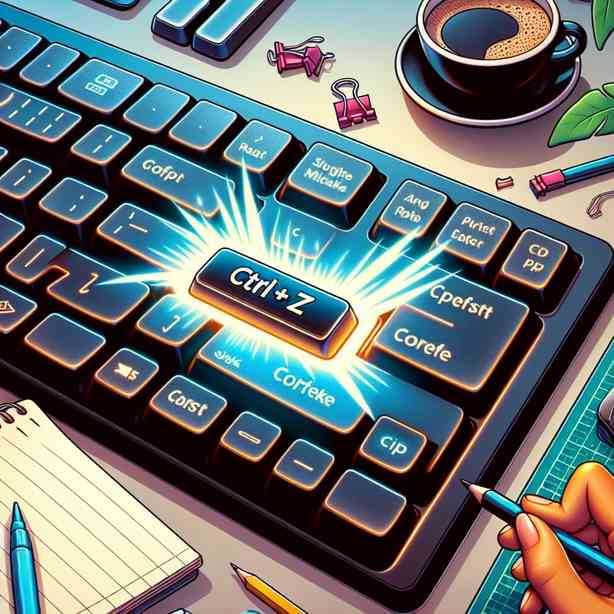
The shortcut CTRL+Z, often referred to as undo, plays an integral role in our daily interactions with technology. It is a command that many users might take for granted, yet its significance is profound. Let’s delve into this function’s history, its practical applications, and the psychological comfort it provides.
CTRL+Z originated in the early days of computing, with its roots traced back to the graphical user interface (GUI) designs in the 1980s. Originally established in programs like text editors and design software, the ability to reverse an action not only eased user anxiety but also fostered creativity. By allowing users to experiment without the fear of making irreversible mistakes, CTRL+Z became a catalyst for innovation. This sense of security encourages individuals to engage more boldly with technology, paving the way for a richer creative experience.
In practical terms, CTRL+Z offers a solution to a range of errors we might encounter while typing or editing documents. A missed keystroke, an unintended deletion, or even a misplaced graphic can be swiftly undone with a simple command. This feature is not limited to just text editing; it extends to various software applications, including graphic design tools, coding environments, and even spreadsheet applications. The universality of this command across different platforms signifies its vital role in enhancing user experience and productivity.
Moreover, CTRL+Z serves as a comforting presence. In a fast-paced digital world, where mistakes seem magnified, having an “undo” option can reduce stress significantly. It allows users to confidently navigate their tasks, knowing that they have a fail-safe mechanism at their disposal. This psychological assurance is essential, particularly for those working under tight deadlines or handling complex projects. By transforming mistakes into manageable hiccups, CTRL+Z cultivates a more forgiving environment for learning and experimentation.
Additionally, let’s consider the integration of CTRL+Z beyond traditional computing environments. Many mobile applications and web-based platforms have begun adopting this command, allowing for a seamless transition between devices. Users find themselves using CTRL+Z not only on their computers but also on their smartphones and tablets. The adaptability of this function reflects a growing trend in technology aimed at creating user-friendly interfaces that prioritize efficiency and ease of navigation.
The educational implications of CTRL+Z are also noteworthy. As students and professionals engage with various learning platforms, the ability to undo actions encourages exploration and risk-taking. Whether it’s coding, writing, or graphic design, learners are more inclined to delve into complex subjects when they know they can backtrack easily. This approach promotes a culture of curiosity, leading to enhanced problem-solving skills and creativity in the learning process.
From a broader perspective, CTRL+Z can be viewed as a metaphor for life itself. It symbolizes the idea that mistakes are an intrinsic part of the learning journey. Just as we can undo a misstep in a document, we often seek opportunities to rectify our own errors in life. Embracing this mentality allows individuals to approach challenges with resilience and optimism, recognizing that second chances are often just a keystroke away.
However, while CTRL+Z is invaluable, it is essential to acknowledge its limitations. There are instances where the command does not function as anticipated, such as when changes have been saved or when one is working in contexts that do not support undo actions. Understanding these boundaries enables users to adopt a more strategic approach to their work, ensuring they are prepared for various scenarios where CTRL+Z may not provide a solution.
As technology continues to evolve, so too does the functionality surrounding the undo command. Developers are constantly exploring ways to enhance this feature, integrating it with artificial intelligence and machine learning to predict user intentions. Innovations such as voice recognition and gesture-based interfaces may redefine how we interact with the undo command in the future, making it even more intuitive and accessible.
In summary, CTRL+Z is more than just a keystroke; it is a powerful tool that promotes creativity, enhances productivity, and offers psychological comfort. Its widespread adoption across various platforms reflects its importance in our daily tasks. Moreover, it serves as a reminder of the learning opportunities that arise from mistakes. Embracing the CTRL+Z mentality can empower individuals to face challenges with courage and resilience, making the journey through both technology and life more enjoyable and fulfilling.
Ultimately, whether you are a student working on an assignment, a professional drafting reports, or an artist creating a masterpiece, the power of CTRL+Z will always be there to support you. Recognizing and appreciating its value can significantly impact how one approaches tasks, enabling a more productive and innovative mindset in the fast-paced digital landscape we navigate today.


